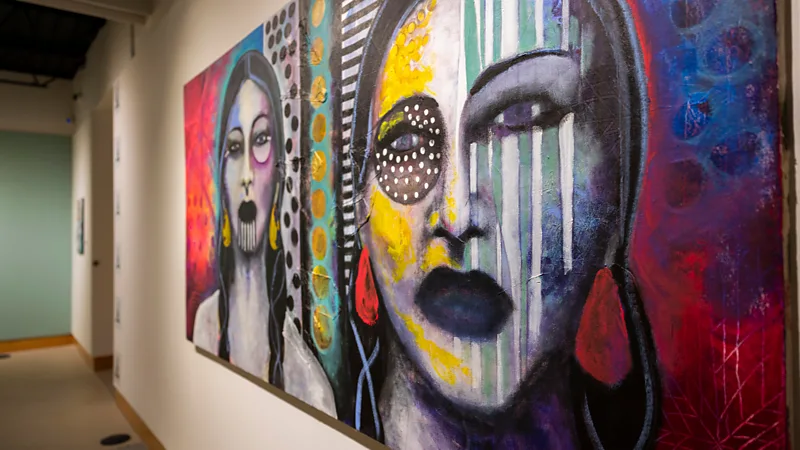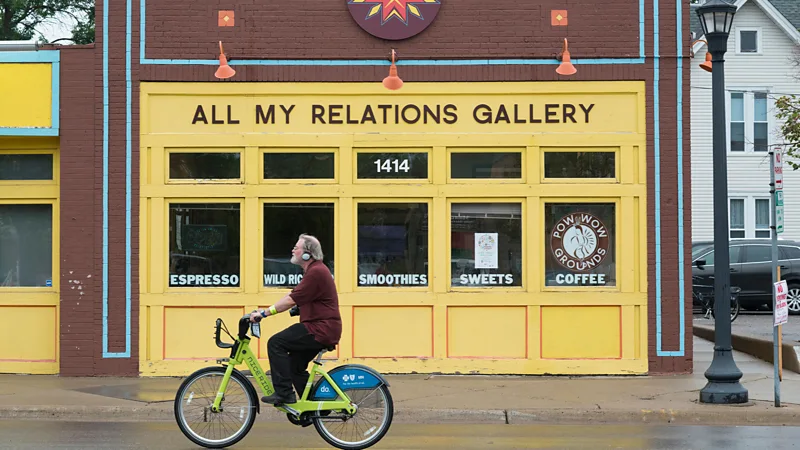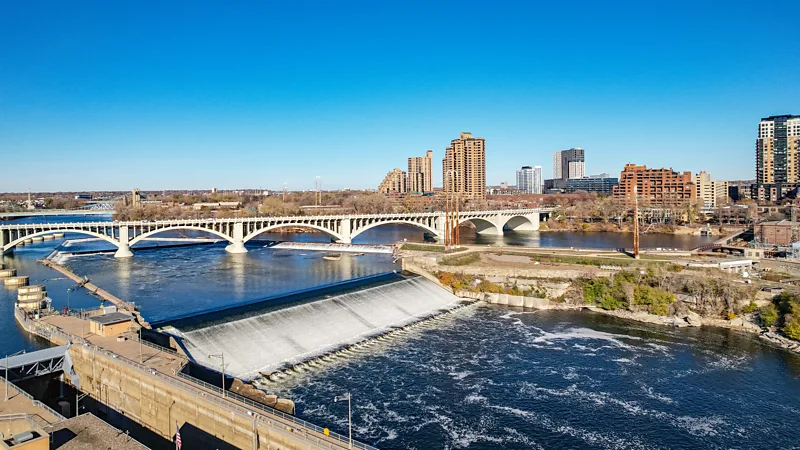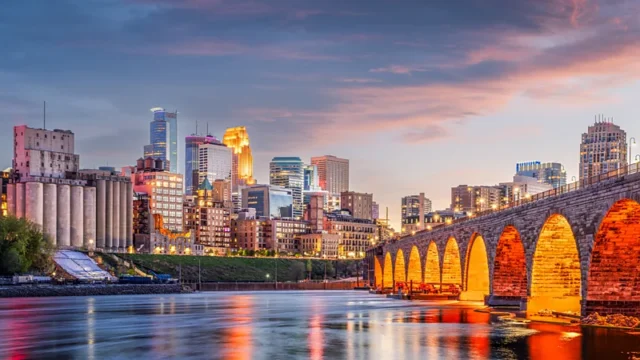Introduction
Minneapolis and its neighboring city, Saint Paul, are experiencing a revival of Indigenous culture, with a deep connection to the Native American communities that have called this region home for centuries. This resurgence is marked by efforts to preserve and honor the cultural heritage of the Dakota people, as well as other Native tribes in the area.
The Sacred Bdote: A Cultural and Historical Landmark
Located south of the Twin Cities, the confluence of the Minnesota and Mississippi rivers, known as Bdote, holds immense cultural significance for the Dakota people. It is regarded as the “center of the Earth” and the birthplace of the Dakota nation. However, this sacred site is also associated with tragedy.
In 1862, the Dakota people faced starvation and displacement due to the encroachment of white settlers. A group of Dakota launched attacks on white settlements, sparking a five-week conflict that led to their exile from their homeland. The US government forcibly relocated the Dakota people to reservations in the Dakotas and Nebraska, but before their departure, many were held at Bdote and Fort Snelling. During that harsh winter, hundreds died from disease and malnutrition, turning the site into a place of sorrow.

The Indian Relocation Act and Its Impact in Minneapolis Indigenous culture
Almost a century later, the Indian Relocation Act of 1956 further disrupted the lives of Native Americans by incentivizing them to leave reservations and move to cities. Many Dakota people returned to the Twin Cities, and today, Minneapolis and Saint Paul have become key centers for Indigenous culture.
The hardships endured during the relocation era, including discrimination and poverty, fueled a cultural renaissance in the Native community. Mike Forcia, a member of the Bad River Band of Lake Superior Chippewa, recalls his family’s struggles in Saint Paul during the late 1960s. He noted that many Native families experienced similar difficulties, facing poverty and a loss of cultural identity as they tried to assimilate into mainstream society.
The Birth of the American Indian Movement (AIM)
In response to widespread discrimination, including police brutality, the Native American community in Minneapolis gathered in 1968 to address these injustices. This gathering gave rise to the American Indian Movement (AIM), a driving force behind the modern Indigenous civil rights movement. AIM played a crucial role in advocating for Native rights, organizing protests, and providing social services to Indigenous communities across the US.
AIM’s efforts reached a national stage in 1972, when representatives occupied the Bureau of Indian Affairs in Washington, DC, as part of the Trail of Broken Treaties protest. Today, AIM continues to advocate for Native sovereignty from its headquarters in Minneapolis, and prominent figures like Lieutenant Governor Peggy Flanagan of the White Earth Band of Ojibwe work to protect and uplift Indigenous culture.

The Indigenous Cultural Renaissance
Minneapolis is now home to a thriving Indigenous cultural scene, with artists, chefs, authors, and community leaders working to restore ancestral traditions. Native creativity is flourishing in art, music, and cuisine, with numerous spaces dedicated to healing, reconciliation, and storytelling.
Native Art on Franklin Avenue
Franklin Avenue East, often considered the heart of Minneapolis’ Indigenous community, is a vibrant hub of Native-designed street art. Many of the buildings along this street feature murals and artwork created by Native artists. One such piece, by artist Natchez Beaulieu, depicts Indigenous women celebrating beneath a starry night sky, showcasing the enduring spirit of Native culture.
Birchbark Books: A Literary Haven in Minneapolis Indigenous culture
In Minneapolis’ Kenwood Park neighborhood, Birchbark Books, an independent bookstore owned by acclaimed author Louise Erdrich (Turtle Mountain Band of Chippewa), highlights the work of Native American authors. The store also features beadwork, red willow baskets, and other crafts made by local Indigenous artisans. Regular readings and events at Birchbark Books celebrate Native storytelling and culture.
Reviving Native Cuisine
Chef Sean Sherman, a member of the Oglala Lakota Sioux tribe, is leading the movement to revive Indigenous cuisine. Growing up on South Dakota’s Pine Ridge Reservation, Sherman realized the need to increase the visibility of Native foods in mainstream culture. In 2015, he founded the North American Traditional Indigenous Food Systems (NĀTIFS) to teach farming techniques and promote nutritional health in Indigenous communities.
Sherman’s Minneapolis-based Indigenous Food Lab offers dishes rooted in pre-colonial traditions, featuring ingredients like bison, wild rice, corn, beans, and squash. His restaurant, Owamni, opened in 2021 and serves food that not only delights the palate but also teaches patrons about Native history. Owamni’s menu exclusively uses pre-colonial ingredients, such as wild game and seasonal produce, to craft dishes that reflect Indigenous culinary traditions.
Restoring Owámniyomni: A Sacred Site
Owamni overlooks the river known as Owámniyomni (“turbulent waters” in Dakota), a sacred site for the Dakota people. For thousands of years, the area served as a place for rituals and treaties. However, industrial development in the 1870s, particularly the construction of mills and a concrete apron, drastically altered the river’s natural flow, desecrating the surrounding land.
Shelley Buck, president of Owámniyomni Okhódayapi and a member of the Bdewakantunwan Dakota, is leading efforts to restore the sacred site and return it to the Dakota people. “Land and cultural restoration are inseparable for the Dakota,” Buck explained. The organization envisions Owámniyomni as a place where Dakota culture and history can be celebrated once again.
Visitors can join guided tours along the river, learning about the area’s significance through interpretive signs in both Dakota and English. The aim is to restore not only the land but also the connection between the Dakota people and their ancestral heritage.
Exploring Indigenous History in Minneapolis
For those interested in learning more about Indigenous history in the region, the Bdote Memory Map offers a valuable resource for exploring significant Native sites around Minneapolis. Additionally, Learning From Place: Bdote offers guided tours led by Dakota people, bringing visitors to three key locations of spiritual and historical significance.
The tour begins at Fort Snelling State Park, where participants learn about the concentration camps that once lined Bdote. It continues to the Indian Mounds Regional Park, a burial site, and Oȟéyawahe/Pilot Knob, a sacred burial ground that has been preserved with natural grasses and trails.

A Cultural Revival in Minneapolis Indigenous culture
As galleries, restaurants, and organizations in the Twin Cities continue to honor the area’s Indigenous past and present, a sense of Native pride is blossoming after centuries of hardship. The Indigenous community in Minneapolis is reclaiming its cultural heritage, creating spaces that celebrate both the joys and traumas of Native life.
Kate Nelson, a local writer of Tlingit origin, encourages visitors to engage deeply with the Native history and culture of the Twin Cities. This cultural renaissance offers an opportunity to connect with the rich traditions and stories of the Indigenous people who have long called this land home.











